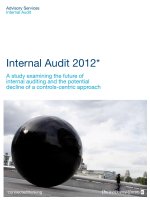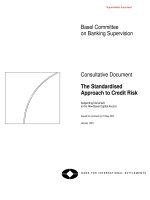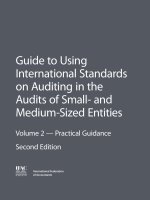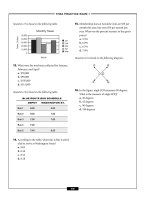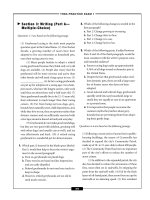ISO 90002000 auditing using the process approach david hoyle john thompson
Bạn đang xem bản rút gọn của tài liệu. Xem và tải ngay bản đầy đủ của tài liệu tại đây (1.71 MB, 164 trang )
ISO 9000:2000 Auditing
Using the Process Approach
This Page Intentionally Left Blank
ISO 9000:2000 Auditing
Using the Process Approach
David Hoyle
John Thompson
An imprint of Elsevier Science
Amsterdam London New York Oxford Paris Tokyo Boston San Diego San Francisco
Singapore Sydney
Butterworth-Heinemann is an imprint of Elsevier Science.
Copyright © 2002, Elsevier Science (USA). All rights reserved.
No part of this publication may be reproduced, stored in a retrieval system, or
transmitted in any form or by any means, electronic, mechanical, photocopying,
recording, or otherwise, without the prior written permission of the publisher.
Recognizing the importance of preserving what has been written, Elsevier Science
prints its books on acid-free paper whenever possible.
© Transition Support Ltd 2001
Original Title: ISO 9000: 2000 Auditor Questions
Original ISBN: 1-903417-04-X
Library of Congress Cataloging-in-Publication Data
A catalog record for this book is available from the Library of Congress.
British Library Cataloging-in-Publication Data
A catalog record for this book is available from the British Library.
The publisher offers special discounts on bulk orders of this book.
For information, please contact:
Manager of Special Sales
Elsevier Science
225 Wildwood Avenue
Woburn, MA 01801-2041
Tel: 781-904-2500
Fax: 781-904-2620
For information on all Butterworth-Heinemann publications available, contact our
World Wide Web home page at:
10 9 8 7 6 5 4 3 2 1
Printed in the United States of America
About the authors
David Hoyle has over 30 years experience in quality management. He held
managerial positions with British Aerospace and Ferranti International. As a
management consultant—first, with Neville-Clarke Ltd and, before forming
Transition Support Ltd, as an independent—he guided such companies as
General Motors, Civil Aviation Authority and Bell Atlantic through their ISO 9000
programs. He has delivered quality management and auditor training courses
throughout the world and has published five books with ButterworthHeinemann on ISO 9000, some of which have been translated into Spanish,
Japanese, and Mandarin. Worldwide sales of his first book, now in its fourth
edition, have totalled over 30,000 copies. He participates in various
committees of the Institute of Quality Assurance and has been engaged in the
revision of ISO 9000. He is a Chartered Engineer, a Fellow of the Institute of
Quality Assurance, an IRCA registered Lead Auditor and a Member of the Royal
Aeronautical Society.
John Thompson is an experienced management consultant in business
improvement; over a 20-year period he has held management positions in
Unilever, RHP Bearings, Mars and Caradon. During the past 12 years and prior
to forming Transition Support Ltd, he was in management consultancy as a
Director of Neville-Clarke Ltd and GPR Consultants Ltd. He assisted
organizations in Europe, the Middle East, and Southeast Asia in their business
improvement activities, including the use of ISO 9000 Baldrige, Singapore
Quality Award and EFQM frameworks. He has helped many organizations to
develop improvement strategies and apply the process approach to system
development and to auditing. These included Anchor Trust, Mars, TRW and
MAFF. He is an adviser to the MTTA on its step change initiative. Initially trained
as a statistician, he has undertaken post-graduate studies in business
administration and is currently completing an MA in human resource
management.
This Page Intentionally Left Blank
Contents
Foreword
ix
Chapter 1
Introduction
1
Chapter 2
Audit methodologies
4
Chapter 3
Quality management principles
20
Chapter 4
The process approach
32
Chapter 5
Questions at the enterprise level
38
Chapter 6
Questions at the managerial level
64
Chapter 7
Questions at the operational level
84
Chapter 8
Assessing business processes
87
Chapter 9
Conclusions
142
Appendix A
Aligning processes with requirements
144
Appendix B
Aligning clauses with key questions
149
vii
The past has only got us to
where we are today
. . . it may not necessarily get
us to where we want to be!
Foreword
The issue of ISO 9000:2000 brought a fundamental change in how the
application of the requirements of the Standard related to an organization’s
approach to Quality Management. The focus on how the organization achieves
its objectives through a set of interconnected processes also brought a
fundamental change in the approach to auditing. Auditing to the new Standard
needs be radically different to that used to audit against previous versions
where the approach concentrated on compliance to specific and individual
requirements, independently of how the system really contributed to achieving
the organization’s objectives—a radical change indeed.
Organizations and the writers of Standards alike recognized that change was
needed and in September 1999 a joint communiqué from the IAF, ISO/TC176
and ISO/CASCO laid down some new and potentially far-reaching requirements
addressing Certification Body auditors. This required auditors to demonstrate
their knowledge and understanding of the 8 Quality management principles.
Auditors are now required to establish that the systems they are auditing have
been based on these principles one of which is the process approach.
The purpose of this book is to provide an effective questioning technique that
will enable auditors to establish that an organization is managing its processes
effectively. This radical new approach to auditing focuses on performance
relative to objectives—not simply on compliance. Auditing will produce results
that will now attract the attention of Management simply because audits are
aligned with the real purpose of management—to improve the organization’s
capability to satisfy its customers and other interested parties.
This book provides auditors with a new approach that will enable them to keep
the focus on the real purpose. At the core of this new approach are five
fundamental questions upon which the process approach is based. From these
a series of questions are derived for several business processes that will reveal
the evidence needed to demonstrate compliance with ISO 9001:2000. At the
same time the robustness of the organization’s processes to achieve their
objectives is tested. The Quality management principles are explained to show
how they can be used to establish that the organization’s management system
is soundly based. The current auditing approaches are evaluated to show the
fundamental weaknesses relative to how audits are planned, conducted and
ix
Foreword
reported. This book contains lots of questions for auditors, structured around
key business processes and linked to the requirements of the Standard.
Where the 1994 version of a standard in the ISO 9000 family is referred to, the
date is mentioned, but for all other references to the ISO 9000:2000 family of
standards the year 2000 has been dropped.
Auditing is a skill that can only be learned through practice. The proficiency of
the auditor is determined not by an ability to rattle off a set of questions and
record the results, but firstly by having a clear idea of what is to be
accomplished and secondly by asking questions that will reveal information of
use to management. It is hoped that the reader will develop a clear idea and
make the transition to a more effective method of auditing. We do not expect
auditors to change tactics overnight but if a few learn this new technique and
organizations benefit from their audits we will have achieved our goal.
x
Chapter 1
Introduction
ISO 9000 as an International standard for providing guidance for designing and
assessing quality management systems was introduced in 1987. The basis of
this standard was originally born out of the defense industry where there was a
long tradition of imposing specific requirements to prevent situations that
experience had shown led to poor product quality. Over the years this approach
has been adopted by thousands of organizations, in fact by the year 2000 the
total number of organizations certificated to ISO 9001, 2 or 3 had exceeded
400,000 covering over 150 countries.
During this time there has been a growing recognition that quality does not
result from simply imposing rules, but from the need for organizations to create
and maintain an environment in which people are motivated to do the right
things right without having to be told. ISO 9000 now reflects that recognition.
The bureaucracy has been replaced by 8 Quality management principles that
(in the words of ISO 9000) aim to help organizations to achieve sustained
success.
For the designers and managers of the organization’s quality management
system these principles are the key to a successful implementation of ISO
9000.
For the auditors they are the key to transforming the way quality system audits
are conducted, as recognized by the International Accreditation Forum (IAF).
In response to ISO 9000:1994 most organizations created documentation that
focused only on those requirements which were addressed by the Standard.
The belief was that by documenting what you do and doing what you document
against each specific requirement in the Standard, product quality would
improve. As some of the principal factors affecting the quality of output were
missing, conformity with ISO 9001:1994 did not stop organizations from
avoiding quality problems.
This narrow view of quality management has now been swept aside by ISO
9000:2000 and in its place it encourages (in the words of ISO 9000)
organizations to:
1
Chapter 1 Introduction
a) determine the needs and expectations of customers and other
interested parties;
b) establish the quality policy and quality objectives of the organization;
c)
determine the processes and responsibilities necessary to attain the
quality objectives;
d) determine and provide the resources necessary to attain the quality
objectives;
e) establish methods to measure the effectiveness and efficiency of each
process;
f)
g)
apply these measures to determine the effectiveness and efficiency of
each process;
determine means of preventing nonconformities and eliminating their
causes;
h) establish and apply a process for continual improvement of the quality
management system.
This simple, yet powerful message is there for all to see and understand.
However, one might be forgiven (but only momentarily) for missing it if on
reading the Standard one only looks for and sees many of the old familiar
phrases. We are creatures of habit and tend to resist change.
It does appear that the committees involved in drafting the Standard tried to
put as many of the old requirements as they could into the new version. It is
clear that an opportunity was missed to create a far simpler, shorter Standard,
even reducing it to a page or two, which would have enabled everyone to see a
clear line of sight from the Standard to customer satisfaction. It would have
been a far more effective design tool and auditing tool for it is the detail
requirements that cause auditors to lose sight of the objectives.
Over the previous 17 years the certification bodies have pursued an approach
of raising nonconformities because either the words in the Standard have not
been met or the organization has not done what it said it would do. There has
been no examination of output results, but it is the improvement of these
results that will improve the competitiveness of industry not conformity with
procedures. Organizations continue with the conformity approach to auditing
because Certification Bodies do the same. Now organizations must change the
2
Chapter 1 Introduction
focus of their quality management system and auditors must change their
approach.
The IAF now requires external auditors to demonstrate knowledge of the Quality
management principles and the concepts and terminology of the Standards.
This will require a change in questioning technique.
No longer will auditors open their questioning with:
“Have you got a procedure for *******? —Show me”
It is more likely to be:
“What improvement in results was obtained from your last review of the
******** process? —Show me”
We call this new technique the process approach to auditing.
It is simple but powerful!
3
Chapter 2
Audit methodologies
Although the audits conducted under the umbrella of ISO 9000 or quality
management are intended to be quality audits rather than financial audits the
trend has been that quality audits focus on procedures and not on quality.
Quality, cost and delivery are inextricably linked and yet auditors in general do
not examine costs or the extent to which products and services are delivered on
time. Quality is a result. It is determined by the extent to which an outcome
meets the needs of those for whom it is provided. If the outcome fails to satisfy
these needs, the outcome is of poor quality. If the outcome meets the needs it
is of good quality. However, since the launch of ISO 9000, quality auditing
within certification bodies and most certificated organizations has ignored the
outcomes and whether those for whom they are provided are satisfied. The
quest in most cases has been to place a “checkmark in a box” leaving the
question of performance unexplored and hence unchallenged. As a result,
auditors fill the boxes with checkmarks and the organization gets the badge
regardless of its actual performance. Hence the retort, “You can produce
rubbish and still obtain ISO 9000 certification provided the rubbish is
consistent rubbish.”
The approach taken by many auditors, both internal and external has been
conditioned by training and observation. Most auditors have been exposed to
conformity auditing where the sole objective is to establish if a specific
requirement has been met. However, the requirement has often not been
focused on a performance result or output but has been focused on a task. To
illustrate this point ISO 9001:1994 clause 4.5.3 required changes to
documents and data to be reviewed and approved. The auditor generally
looked to establish that a procedure existed that required such action and
proceeded to examine changes for evidence that these had been reviewed and
approved. Having found the evidence, it was assumed that the requirement had
been met. One swallow does not make a summer, therefore the auditor may
have looked for other document changes to check that they too had been
reviewed and approved. After gathering the evidence, the auditor made a
conformity judgment—not a performance judgment—that documents were
reviewed and approved for adequacy prior to issue. The auditor probably did
not search for the approval criteria or for evidence that the people concerned
4
Chapter 2 Audit methodologies
were competent to approve the change or for evidence that the change was
indeed necessary—that it would improve performance! So how could a decision
be made that the documents are in fact adequate—i.e., fit for their intended
purpose? The decision is usually made from the evidence that those who
approved the documents were authorized to do so. The audit revolves around
documents and whether or not they are approved—not whether the information
needed to perform the job is available and its integrity is assured.
It has been this pre-occupation with approval of documents and tasks that has
contributed to the statement that ISO 9000 and Quality Management systems
are bureaucratic nightmares that add no real value to the organization and
generate “nit-picking” auditors.
In general, the questions any auditors ask are conditioned by the plan they
have developed and the strategy taken to discover the answers. There are a
number of approaches generally used in conducting internal and external
quality system audits and each can be characterized by:
♦
♦
♦
♦
the way the audit is planned (this affects what the auditor looks at
and the order in which the audit is performed)
the way checklists are produced (this affects what the auditor looks
for and the questions the auditor will ask)
the way the auditor conducts the audit (this affects the speed at
which evidence is collected and its significance determined)
the way the auditor reaches conclusions (this affects the validity of
the results).
As each organization conducting audits will have evolved its own techniques
there are no definitive methods but what follows illustrates the distinguishing
features of three generic approaches. Only those aspects of the audit that
relate to the auditor’s questions are addressed. The preparation, analysis and
reporting activities are omitted.
The element approach
With the element approach the auditor uses the elements of the governing
Standard, e.g., ISO 9001:1994, as the basis for planning and conducting the
audit. An element in this context is a subsection of the Standard of which there
are 20 in section 4 of ISO 9001:1994.
5
Chapter 2 Audit methodologies
Approach to planning the audit
The audit plan follows the elements of the Standard such that it commences
with an examination of element 4.1 on Management Responsibility and ends
with an examination of element 4.20 on Statistical Techniques. The audit
schedule may not follow the elements in a numerical order as this will depend
upon location and timing, but in principle, each element is matched with a
person or department within the organization. When the auditor arrives in the
selected department, the audit scope is limited to establishing conformity only
with those requirements that are addressed by the corresponding element of
the standard. Although many elements apply to each department the auditor
primarily focuses on the most appropriate element for that department. The
only departments in the plan are those that are perceived to be within the
scope of the registration. An example is shown in Table 2.1.
6
Chapter 2 Audit methodologies
Table 2.1 Element-based audit plan
Element
4.1
4.2
4.3
4.4
4.5
4.6
4.7
4.8
4.9
4.10
4.11
4.12
4.13
4.14
4.15
4.16
4.17
4.18
4.19
4.20
Title
Management
responsibility
Quality system
Contract review
Design control
Document and data
control
Purchasing
Customer supplied
product
Product
identification &
traceability
Process control
Inspection and test
Inspection,
measuring and test
equipment
Inspection and test
status
Nonconforming
material
Corrective and
preventive action
Handling, storage,
packaging,
preservation and
delivery
Control of quality
records
Internal quality
audit
Training
Servicing
Statistical
techniques
Department
General
manager
Quality
Sales
Design
Auditor
Time
Quality
Purchasing
Production
Production
Production
Inspection
Calibration
Inspection
Inspection
Quality
Shipping
Quality
Quality
Personnel
Servicing
Production
7
Chapter 2 Audit methodologies
Approach to checklists
The checklists tend to be complied by taking each “shall” statement and
rewriting the requirement of the Standard in the form of a question. This
approach is applied in external audits (second and third party) and internal
system audits.
Approach to audit conduct
The auditor commences the audit by asking the first question off the checklist.
Hence if the requirement is for the quality policy to be defined, the auditor
would ask “What is your quality policy?” followed by “Where is the policy
defined?” and possibly “Who defined this policy?” If a document is produced
this might be followed by “Who approved this and how do you know it is up to
date?”, illustrating that Document Control (Element 4.5) is not far away.
The auditors tend to look for specific evidence in the belief that if they find it,
the organization is compliant. For example when seeking compliance with
element 4.3 on contract review, the auditor would ask “Have you got a
procedure for contract review?” When shown the procedure the auditor would
examine to see if it covered the other requirements in element 4.3 of the
Standard and then ask to see some records of contract review. When satisfied
the records provided evidence that the requirements had been addressed the
auditor would move on to the next element. If a record could not be found or a
signature was missing or a record was not in the format the organization
specified in its procedure, a nonconformity report would be issued.
Approach to conclusions
The auditor seeks nonconformity and reaches a conclusion on the number of
nonconformities found in the samples taken. The auditor often seeks one
example to test compliance in one area and bases decisions on whether
conformity was found. Sometimes an auditor will examine several pieces of
evidence seeking nonconformity and when one is found, go no further. Often
the search stops at the department boundary. Nonconformities are classified
on the basis that if a requirement of the Standard has not been met, no matter
how insignificant, a major nonconformity is issued. If a procedure has not been
followed and the requirement in the procedure is not one addressed by the
Standard then a minor nonconformity is issued.
8
Chapter 2 Audit methodologies
Advantages of the element approach
The element approach:
♦
♦
♦
♦
♦
♦
♦
♦
is simple to use
can be learned by almost anyone
requires little understanding of the organization
is favored by accreditation bodies
is easily verified by examination of audit reports
creates a high degree of consistency
lends itself to scoring using a numerical scale
puts the badge on the wall.
Disadvantages of the element approach
The approach is not effective because:
♦
♦
♦
♦
♦
♦
♦
♦
♦
♦
♦
♦
♦
♦
♦
♦
♦
the effectiveness of the system is not determined
there is no assessment of the results which the system delivers
conformity with requirements that apply to more than one
department is not tested apart from Document Control
linkages between departments are not tested
linkages between processes are not tested
the questions in the checklist are theoretical and will not be the
actual questions asked
the checks will not follow the flow of work through the organization
if used rigidly, it will confuse the auditee as to what the auditor is
trying to establish
if the checks are not tailored to the specific organization, the auditee
will get the impression that the auditor is not interested in
understanding how the organization functions
the quest is for documentation and not effectiveness
the focus is on conformity with the written procedures
it is assumed that conformity with requirements is indicative that the
operations are under control
the auditor overlooks the factors that will determine that the
operations are under control and that the controls are effective
there is little examination of product or process
no judgment is made on the significance of the findings
there is no test for frequency of occurrence
there is no examination in other areas to see if problems identified
are deep rooted
9
Chapter 2 Audit methodologies
♦
♦
♦
there is no search for the root cause
there is an assumption that correcting any nonconformity will
improve organizational effectiveness
auditors need to be familiar with the industry to know what to look
for.
As a result there is little added value. The auditor rarely finds problems of which
the organization is not already aware. It results in a paper chase and time spent
correcting minor problems that have little impact on organizational
effectiveness.
The departmental approach
With the departmental approach, the auditor starts with the organization’s
departments and seeks conformity with those requirements of the Standard
that apply to each department. Internal and external auditors use this
approach.
Approach to planning the audit
The audit plan is based on the organization chart, with those departments that
come within the scope of registration being allotted timeslots in the audit
schedule. As with the element approach, Management Responsibility still
features in departmental audits and is allotted to General Management.
However, requirements within element 4.1 are tested in each department. A
typical departmental audit plan is illustrated in Table 2.2.
In practice the auditor may not check conformity with all requirements that
apply to a particular department but the chances are that evidence of
conformity will be gathered from more than one department.
10
Servicing
Personnel
Calibration
Shipping
Inspection
Production
Purchasing
Design
Sales
Quality
Management
Department
Auditor Date
4.1
4.2
4.3
4.4
4.5
4.6
4.7
4.8
4.9 4.10 4.11 4.12 4.13 4.14 4.15 4.16 4.17 4.18 4.19 4.20
Chapter 2 Audit methodologies
Table 2.2 Department-based audit plan
11
Chapter 2 Audit methodologies
Approach to checklists
The checklists tend to be compiled by collecting the relevant element checklists
together and putting them in some sort of order that will allow the auditor to
follow a trail through the department. With internal audits, the focus is on
checking conformity with procedures and therefore the checklist will identify the
general company procedures and relevant departmental procedures that apply.
Checklists often cite questions taken from the requirements of the Standard
but will pick up additional questions from the departmental procedures.
Approach to audit conduct
The auditor seeks out the department manager and asks questions from the
checklist related to the procedures issued for that department. As many more
elements of the Standard are addressed in each department the auditor will
jump from requirement to requirement and may follow trails through the
department but will stop at the department boundary. The objective is to
establish whether the department’s staff follow the documented procedures
and so the trails will be dictated by linkages between procedures signaled by
cross references within each procedure. For example when examining a
procedure or an instruction the auditor may look for evidence that the
document is under control, has a signature, has a revision status etc. Questions
also tend to contain the expected result such as “Where do you get your
instructions from?” implying that they should come from somewhere, “Where
are the results of those checks recorded?”—implying that results should be
recorded and “What is the quality policy?”—implying that the person should
know the quality policy.
Approach to conclusions
The auditor using the departmental approach may seek conformity and in doing
so stumble across a nonconformity. As with the element approach the auditor
may only take one sample in testing conformity. If the evidence presented in
response to the questions conforms to the procedure, the procedure is
assumed to be implemented and effective.
12
Chapter 2 Audit methodologies
Advantages of the departmental approach
The departmental approach:
♦
♦
♦
♦
♦
checks compliance with the requirements in the areas to which they
apply
follows work flow through a department
focuses on departmental issues and hence will cause less confusion
focuses on departmental processes and products
puts the badge on the wall.
The weaknesses of the departmental approach
The approach is not effective because:
♦
♦
♦
♦
♦
♦
♦
♦
♦
♦
♦
♦
♦
♦
♦
the effectiveness of the system is not determined
there is no assessment of the results which the system delivers
linkages between departments are not tested
linkages between processes are not tested
the questions in the checklist are theoretical and will not be the
actual questions asked
the checks are focused on conformity not effectiveness
the quest is for documentation and not effectiveness
the focus is on conformity with the written procedures
it is assumed that conformity with procedures is indicative that the
operations are under control
no judgment is made on the significance of the findings
there is no test for frequency of occurrence
there is no examination in other departments to see if problems
identified are deep rooted
there is no search for the root cause
there is an assumption that correcting any nonconformity will
improve organizational effectiveness
auditors need some knowledge of the industry to know how to
generate questions from procedures and what to look for.
Task-based approach
The task-based approach is not dissimilar to the departmental approach and
may well be used on a departmental basis. With this approach the auditor
identifies the work areas to visit and on arrival seeks to establish what tasks
13
Chapter 2 Audit methodologies
are performed there. The auditor then proceeds to gather facts about the task
in terms of the person performing or supervising the task, items being worked
on, equipment used to perform the task and information used or generated by
the task. The auditor will tend to make notes of items to be checked elsewhere,
e.g., a person’s name (so that a training record might be checked), an
equipment number (so that its calibration status might be checked). The
primary difference is that the task approach uses a task element framework as
the basis for revealing evidence rather than a set of requirements such as ISO
9000.
Approach to planning the audit
The task-based approach would be planned in the same way as departmental
audits but could be based on a series of work areas regardless of which
department they were located. The plan starts with the customer requirements
and proceeds through all the work areas that lead to completed output.
Approach to checklists
Checklists would focus on a particular task and identify the questions relative
to the four tasks elements (person, item, equipment, information). Often a flow
chart is used in planning the checklist, either taken from the organization’s
procedures or drawn by the auditor.
Approach to audit conduct
The auditor interviews an individual to establish that the tasks being performed
are compliant with the requirements for the task. The audit may commence at
the starting point for a contract, product or project and proceed forward to
completion, or may start with the end result and trace backward through all
relevant work areas to the starting point.
Approach to conclusions
The auditor using the task-based approach would seek out sufficient examples
to prove conformity with the requirements but the focus remains on whether
the tasks have been performed in accordance with the requirements. The
approach reveals not only whether procedures have been followed but also
whether the procedures adequately address the requirements of the governing
standards. As the requirements may tend to be very prescriptive, evidence will
14


